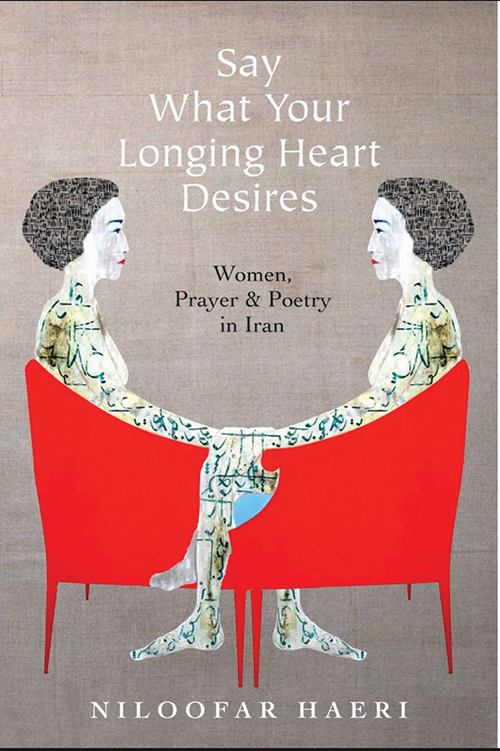
Say What Your Longing Heart Desires: Women, Prayer, and Poetry in Iran
Reviewed by Karie Firoozmand
April 1, 2022
By Niloofar Haeri. Stanford University Press, 2020. 224 pages. $85/hardcover; $25/paperback or eBook.
Students and teachers of comparative religion will appreciate this fresh and unusual way to learn about how Iranians practice Islam. It explores the connection between Iran’s body of mystical poetry and the prayer life of a few real women. These women, whom Haeri calls her “interlocutors,” share their relationships to poetry and prayer over their lifetimes. Readers get the rare gift of hearing the women’s words and reading about events in their lives. As Haeri points out, we in the West don’t often get that intimacy with Muslims in general or Iranians in particular.
Knowing a few things about Iranians (also called Persians) helps to understand not only this book but their practice of Islam. First, the Qur’an is written in Arabic, but Iranians speak Farsi. Their Qur’ans include translation, of which there are many. When the women in this book pray five times a day, they are saying Qur’anic verses in Arabic. But when they pray at other times, or after they’ve finished the v,erses, it’s most often in Farsi.
I was fascinated by this: the ritual prayer is called namaz, a word I knew, but I learned the word do’a (meaning intimate, spontaneous prayer) when I read this book. Haeri writes that “[t]here is something paradoxical about do’a: it is neither required nor a ritual . . . but doing it shows perhaps a stronger commitment to . . . God than ritual prayer does. . . .” I believe that, to a Quaker, do’a is anything but paradoxical. To know about it can change our perception of Iranians in their identity as Muslims, and that’s a powerful thing.
Another key to this book is Iranians’ relationship to their poetry. If the English of Shakespeare were like the English of today, we would feel a closeness to the Bard that Iranians feel to Rumi, Hafez, Saadi, Khayyam, and Ferdowsi. It’s accessible even though these poets lived many centuries ago. The twentieth-century poet that belongs in this company is Parvin Etesami, a woman who is read, recited, and loved much like the others. Iranians memorize and recite these poets, beginning at home or in elementary school. It’s as if we could quote Shakespeare’s sonnets starting in first grade, or as if Chaucer (who was contemporaneous with Hafez) were as readable as Robert Frost.
I point this out because it’s overwhelmingly ordinary among Iranians to memorize these poets. Shrines to Iranian classical poets are popular spots to visit. In the decades leading up to the 1979 Islamic revolution, popular radio shows played Iran’s most popular singers—often women—singing poems put to music. (Today, women can again be broadcast, but it was long forbidden for women to sing in public, let alone be broadcast after the revolution.)
The relationship of poetry and prayer, though, is what Haeri explores in this book. She names both as “forms of eternal knowledge.” Just as namaz may allow one to sink down to the seed, and just as do’a creates intimacy with God, so does the body of mystical poetry in Iran help way to open for the seeker, “offer[ing] a stream of ideas with which one can grapple over a lifetime . . . it encourages pondering the qualities of [one’s] relationship to the divine.” Haeri’s thesis is that mystical poetry “braids” mysticism into religiosity, that it can be a “companion to the prayers” learned in childhood. That’s an important statement for a Western audience; usually, we see images of namaz taking place in mosques, reinforcing the idea that Islam is a rigid set of rules and rituals rather than a guide to the living God, with the Qur’an as the guidebook.
There’s a truth about the practice of namaz that Quakers—especially unprogrammed ones—might find interesting. Haeri describes the way namaz works for some people. Rather than the mere repetition of words, practicing namaz over time creates “the emergence and proliferation of meaning, rather than a fixing and fading of it.” Such a possibility reminds me of lectio divina or other ways of deepening the reading of prayers that are written rather than spontaneous. And like the Bible’s advice to pray in private and not to make a show of it, Saadi cautions that “It is the key to the gate of hell that namaz / That you perform in front of others.”
I jumped at the chance to review this book. Because I’ve been married to an Iranian for many years, I have an existing knowledge base of their culture and language. It also reminded me (as if I could ever forget) of visiting Hafez’s shrine in Shiraz, Iran. I did not expect to see people, quite at rest and seated all around the sarcophagus. I entered that space in curiosity and incredulity: here do’a was present, and it was something palpable, very like the contemplative worship of my own Quaker meeting, half a world away. (You can read my FJ article, “A Place of Stillness in Iran,” in the October 2016 issue.)
Karie Firoozmand is a member of Stony Run Meeting in Baltimore, Md. She exercised great restraint in the length of this review, as Iranian culture is a subject of great interest to her.


